Outline of human anatomy
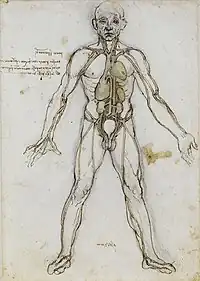 |
| Part of a series of lists about |
| Human anatomy |
|---|
The following outline is provided as an overview of and topical guide to human anatomy:
Human anatomy – scientific study of the morphology of the adult human. It is subdivided into gross anatomy and microscopic anatomy. Gross anatomy (also called topographical anatomy, regional anatomy, or anthropotomy) is the study of anatomical structures that can be seen by unaided vision. Microscopic anatomy is the study of minute anatomical structures assisted with microscopes, and includes histology (the study of the organization of tissues), and cytology (the study of cells).
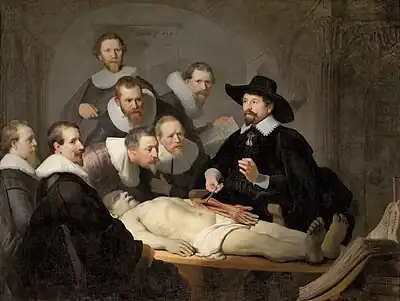
Essence of human anatomy
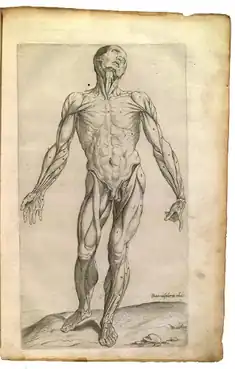
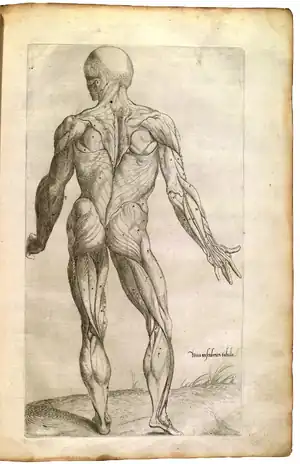
Branches of human anatomy
- Gross anatomy- systemic or region-wise study of human body parts and organs. Gross anatomy encompasses cadaveric anatomy and osteology
- Microscopic anatomy/histology
- Cell biology (Cytology) & cytogenetics
- Surface anatomy
- Radiological anatomy
- Developmental anatomy/embryology
Anatomy of the human body
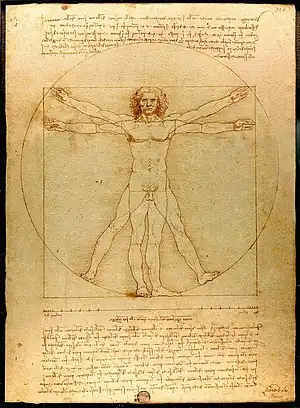
The following list of human anatomical structures is based on the Terminologia Anatomica, the international standard for anatomical nomenclature. While the order is standardized, the hierarchical relationships in the TA are somewhat vague, and thus are open to interpretation.
General anatomy
- Parts of human body
- Head
- Neck
- Trunk
- Upper limb
- Lower limb
- Cavities
- Cranial cavity
- Spinal cavity
- Thoracic cavity
- Abdominopelvic cavity
- Planes, lines, and regions
- Regions of head
- Regions of neck
- Anterior and lateral thoracic regions
- Abdominal regions
- Regions of back
- Perineal regions
- Regions of upper limb
- Regions of lower limb
Bones

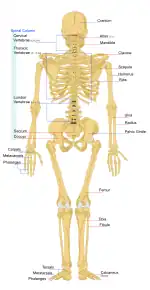
- General terms
- Bony part
- Cartilaginous part
- Membranous part
- Axial skeleton
- Appendicular skeleton
- Long bone
- Short bone
- Flat bone
- Irregular bone
- Pneumatized bone
- Sesamoid bone
- Diaphysis
- Epiphysis
- Epiphysial plate (Growth plate)
- Metaphysis
- Apophysis
- Tuber
- Tubercle
- Tuberosity
- Eminence (anatomy)
- Process
- Condyle
- Epicondyle
- Fossa
- Medullary cavity
- Endosteum
- Yellow bone marrow
- Red bone marrow
- Nutrient foramen
- Nutrient canal
- Ossification center
- Cranium
- Neurocranium
- Viscerocranium
- Cranial cavity
- Forehead
- Occiput
- Nasion
- Bregma
- Lambda
- Inion
- Pterion
- Asterion
- Gonion
- Temporal fossa
- Zygomatic arch
- Infratemporal fossa
- Pterygopalatine fossa
- Pterygomaxillary fissure
- Fontanelles
- Calvaria
- Cranial base
- Internal surface of cranial base
- Petrosphenoidal fissure
- Petro-occipital fissure
- Anterior cranial fossa
- Middle cranial fossa
- Posterior cranial fossa
- External surface of cranial base
- Internal surface of cranial base
- Orbit
- Nasolacrimal canal
- Bony nasal cavity
- Bones of cranium
- Parietal bone
- Frontal bone
- Squamous part
- External surface
- Glabella
- Frontal suture
- Supra-orbital margin
- Supra-orbital notch (Supra-orbital foramen)
- Internal surface
- External surface
- Frontal sinus
- Squamous part
- Occipital bone
- Sphenoid
- Body
- Lesser wing
- Greater wing
- Temporal bone
- Petrous part
- Mastoid process
- Occipital groove
- Mastoid foramen
- Facial canal
- Inferior surface of petrous part
- Tympanic cavity
- Mandibular fossa
- Articular tubercle
- Petrotympanic fissure
- Petrosquamous fissure
- Petrous part
- Ethmoid
- Cribriform plate
- Cribriform foramina
- Crista galli
- Ethmoidal labyrinth
- Inferior nasal concha
- Lacrimal bone
- Nasal bone
- Vomer
- Maxilla
- Body of maxilla
- Orbital surface
- Anterior surface
- Maxillary sinus
- Palatine process
- Alveolar process
- Body of maxilla
- Palatine bone
- Zygomatic bone
- Mandible
- Body of mandible
- Mental protuberance
- Mental tubercle
- Mental foramen
- Oblique line
- Superior mental spine
- Inferior mental spine
- Mylohyoid line
- Sublingual fossa
- Submandibular fossa
- Alveolar part
- Ramus of mandible
- Angle of mandible
- Mandibular foramen
- Mylohyoid groove
- Coronoid process
- Mandibular notch
- Condylar process
- Body of mandible
- Hyoid bone
- (Auditory ossicles - see sense organs)
- Vertebral column
- Vertebral canal
- Vertebra (this category contains parts of a vertebra)
- Cervical vertebrae
- Uncus of body
- Foramen transversarium
- Carotid tubercle
- Atlas (anatomy)
- Axis (anatomy)
- Vertebra prominens (C7)
- Thoracic vertebrae
- Lumbar vertebrae
- Sacrum
- Dorsal surface
- Sacral cornu
- Sacral canal
- Dorsal surface
- Coccyx
- Thoracic skeleton
- Ribs
- Rib
- Body
- Cervical rib
- First rib
- Lumbar rib
- Sternum
- Manubrium of sternum
- Clavicular notch
- Jugular notch
- Sternal angle
- Xiphoid process
- Manubrium of sternum
- Thoracic cage
- Bones of upper limb
- Pectoral girdle
- Free part of upper limb
- Bones of hand
- Carpal bones
- Metacarpals
- Phalanges (hand)
- Sesamoid bones (hand)
- Bones of lower limb
- Pelvic girdle
- [Sacrum - see vertebrae section]
- Hip bone
- Pelvis (category contains general terms)
- Free part of lower limb
- Bones of foot
- Pelvic girdle
Joints
- General terms
- Joint
- Bony joints
- Synarthrosis
- Synovial joint
- Articular disc
- Meniscus
- Synovial bursa
- Synovial sheath
- Plane joint
- Cylindrical joint
- Bicondylar joint
- Saddle joint
- Condylar joint
- Ball and socket joint
- Abduction
- Adduction
- External rotation or Lateral rotation
- Internal rotation or Medial rotation
- Circumduction
- Flexion
- Extension
- Pronation
- Supination
- Opposition
- Reposition
- Joints of the skull
- Cranial fibrous joints
- Cranial syndesmoses
- Cranial sutures
- Dento-alveolar syndesmosis (gomphosis)
- Cranial cartilaginous joints
- Cranial synchondroses
- Cranial synovial joints
- Cranial fibrous joints
- Vertebral joints
- Syndesmoses of vertebral column
- Synchondroses of vertebral column
- Intervertebral joint
- Vertebral synovial joints
- Thoracic joints
- Syndesmoses of thorax
- External intercostal membrane
- Internal intercostal membrane
- Synchondroses of thorax
- Costosternal joint
- Synchondrosis of first rib
- Sternal synchondroses
- Synovial joints of thorax
- Syndesmoses of thorax
- Joints of upper limb
- Joints of pectoral girdle
- Syndesmoses of pectoral girdle
- Synovial joints of pectoral girdle
- Joints of free upper limb
- Radio-ulnar syndesmosis
- Synovial joints of free upper limb
- Glenohumeral joint
- Elbow joint (since merged with elbow article)
- Distal radio-ulnar joint
- Joints of hand
- Joints of pectoral girdle
- Joints of lower limb
- Joints of pelvic girdle
- Syndesmoses of pelvic girdle
- Joints of free lower limb
- Tibiofibular syndesmosis
- Synovial joints of free lower limb
- Hip joint
- Knee joint
- Tibiofibular joint
- Joints of foot
- Ankle joint
- Subtalar joint
- Transverse tarsal joint
- Cuneonavicular joint
- Intercuneiform joints
- Tarsal ligaments
- Tarsal interosseous ligaments
- Dorsal tarsal ligaments
- Dorsal cuneonavicular ligament
- Plantar tarsal ligaments
- Plantar calcaneonavicular ligament (Spring ligament)
- Tarsometatarsal joints
- Intermetatarsal joints
- Metatarsophalangeal joints
- Interphalangeal joints of foot
- Joints of pelvic girdle
Muscles
- General terms
- Muscles of head
- Extra-ocular muscles (see sense organs)
- Muscles of auditory ossicles (see sense organs)
- Facial muscles
- Epicranius
- Procerus
- Nasalis
- Depressor septi nasi
- Orbicularis oculi
- Corrugator supercilii
- Depressor supercilii
- Auricularis anterior
- Auricularis superior
- Auricularis posterior
- Orbicularis oris
- Depressor anguli oris
- Transversus menti
- Risorius
- Zygomaticus major
- Zygomaticus minor
- Levator labii superioris
- Levator labii superioris alaeque nasi
- Depressor labii inferioris
- Levator anguli oris
- Modiolus
- Buccinator
- Mentalis
- Masticatory muscles
- Muscles of tongue - see alimentary system
- Muscles of soft palate and fauces - see alimentary system
- Muscles of neck
- Platysma
- Longus colli
- Longus capitis
- Scalenus anterior
- Scalenus medius
- Scalenus posterior
- Sternocleidomastoid
- Suboccipital muscles
- Suprahyoid muscles
- Infrahyoid muscles
- Cervical fascia
- Muscles of back
- Trapezius
- Latissimus dorsi
- Rhomboid major
- Rhomboid minor
- Levator scapulae
- Serratus posterior inferior
- Serratus posterior superior
- Anterior cervical intertransversarii
- Lateral posterior cervical intertransversarii
- Intertransversarii laterales lumborum
- Muscles of back proper
- Erector spinae
- Erector spinae aponeurosis
- Iliocostalis
- Longissimus
- Spinalis
- Spinotransversales
- Transversospinales
- Interspinales
- Intertransversarii
- Thoracolumbar fascia
- Erector spinae
- Muscles of thorax
- Pectoralis major
- Pectoralis minor
- Subclavius
- Serratus anterior
- Levatores costarum
- External intercostal muscle
- Internal intercostal muscle
- Innermost intercostal muscle
- Subcostales
- Transversus thoracis
- Pectoral fascia
- Clavipectoral fascia
- Thoracic fascia
- Endothoracic fascia
- Thoracic diaphragm
- Muscles of abdomen
- Rectus abdominis
- Pyramidalis
- External oblique
- Superficial inguinal ring
- Internal oblique
- Transversus abdominis
- Linea alba
- Linea semilunaris
- Inguinal canal
- Quadratus lumborum
- Abdominal fascia
- Pelvic fascia
- Pelvic diaphragm
- Levator ani
- Ischiococcygeus
- External anal sphincter
- Perineal muscles - see genital systems
- Muscles of upper limb
- Compartments
- Muscles
- Deltoid
- Supraspinatus
- Infraspinatus
- Teres minor
- Teres major
- Subscapularis
- Biceps brachii
- Coracobrachialis
- Brachialis
- Triceps brachii
- Anconeus
- Pronator teres
- Flexor carpi radialis
- Palmaris longus
- Flexor digitorum superficialis
- Flexor digitorum profundus
- Flexor pollicis longus
- Pronator quadratus
- Brachioradialis
- Extensor carpi radialis longus
- Extensor carpi radialis brevis
- Extensor digitorum
- Extensor digiti minimi
- Extensor carpi ulnaris
- Supinator
- Abductor pollicis longus
- Extensor pollicis brevis
- Extensor pollicis longus
- Extensor indicis
- Palmaris brevis
- Abductor pollicis brevis
- Flexor pollicis brevis
- Opponens pollicis
- Adductor pollicis
- Abductor digiti minimi
- Flexor digiti minimi brevis
- Opponens digiti minimi
- Lumbricals of hand
- Dorsal interossei (of hand)
- Palmar interossei (of hand)
- Fascia
- Muscles of lower limb
- Compartments
- Muscles
- Iliopsoas
- Gluteus maximus
- Gluteus medius
- Gluteus minimus
- Tensor fasciae latae
- Piriformis
- Obturator internus
- Gemellus superior
- Gemellus inferior
- Quadriceps femoris
- Articularis genus
- Pectineus
- Adductor longus
- Adductor brevis
- Adductor magnus
- Gracilis
- Obturator externus
- Biceps femoris
- Semitendinosus
- Semimembranosus
- Tibialis anterior
- Extensor digitorum longus
- Fibularis tertius
- Extensor hallucis longus
- Fibularis longus
- Fibularis brevis
- Triceps surae
- Plantaris
- Popliteus
- Tibialis posterior
- Flexor digitorum longus
- Flexor hallucis longus
- Extensor hallucis brevis
- Extensor digitorum brevis
- Abductor hallucis
- Flexor hallucis brevis
- Adductor hallucis
- Abductor digiti minimi
- Flexor digiti minimi brevis
- Flexor digitorum brevis
- Quadratus plantae
- Lumbricals
- Dorsal interossei
- Plantar interossei
- Fascia
- Tendon sheaths and bursae
- Bursae of neck
- Bursae of upper limb
- Tendinous sheaths of upper limb
- Bursae of lower limb
- Tendinous sheaths of lower limb
Alimentary system
- Mouth
- Oral cavity
- Oral vestibule
- Oral cavity proper
- Glands of mouth
- Major salivary glands
- Minor salivary glands
- Teeth
- Tongue
- Oral cavity
- Fauces
- Muscles of soft palate and fauces
- Pharynx
- Nasopharynx
- Oropharynx
- Laryngopharynx
- Pharyngeal muscles
- Superior pharyngeal constrictor
- Middle pharyngeal constrictor
- Inferior pharyngeal constrictor
- Stylopharyngeus
- Salpingopharyngeus
- Palatopharyngeus - see 'Muscles of soft palate and fauces'
- Esophagus
- Stomach
- Small intestine
- Large intestine
- Liver
- Gall bladder
- Pancreas
Respiratory system
Thoracic cavity
The thoracic cavity is the chamber of the body of vertebrates that is protected by the thoracic wall. The central compartment of the thoracic cavity is the mediastinum.
Urinary system
Genital systems
- Female reproductive system
- Female internal genitalia
- Female external genitalia
- Male reproductive system
- Male internal genitalia
- Male external genitalia
- Penis
- Male urethra
- Spongy urethra
- Scrotum
- Dartos fascia
- Perineum
- Perineal body
- Subcutaneous perineal pouch
- Superficial perineal pouch
- Deep perineal pouch
- Ischio-anal fossa
Abdominopelvic cavity
- Extraperitoneal space
- Peritoneum
- Mesentery
- Mesocolon
- Lesser omentum
- Hepatophrenic ligament
- Hepato-esophageal ligament
- Hepatogastric ligament
- Hepatoduodenal ligament
- Greater omentum
- Gastrophrenic ligament
- Gastrosplenic ligament
- Phrenicosplenic ligament
- Splenorenal ligament
- Pancreaticosplenic ligament
- Pancreaticocolic ligament
- Splenocolic ligament
- Phrenicocolic ligament
- Peritoneal attachments of liver
- Recesses, fossae, and folds
- Urogenital peritoneum
- Vesico-uterine pouch
- Broad ligament of uterus
- Mesometrium
- Mesosalpinx
- Mesovarium
- Suspensory ligament of ovary - see genital systems
Endocrine glands
- Pituitary gland
- Pineal gland
- Thyroid gland
- Suprarenal gland
- Pancreatic islets - see alimentary system
Cardiovascular system
- General terms
- Heart
- Arteries
- Pulmonary trunk
- Aorta
- Ascending aorta
- Aortic arch
- Brachiocephalic trunk
- Common carotid artery
- External carotid artery
- Superior thyroid artery
- Ascending pharyngeal artery
- Lingual artery
- Facial artery
- Occipital artery
- Posterior auricular artery
- Superficial temporal artery
- Maxillary artery
- Deep auricular artery
- Anterior tympanic artery
- Inferior alveolar artery
- Middle meningeal artery
- Pterygomandibular artery
- Masseteric artery
- Anterior deep temporal artery
- Posterior deep temporal artery
- Buccal artery
- Posterior superior alveolar artery
- Infra-orbital artery
- Artery of pterygoid canal
- Descending palatine artery
- Sphenopalatine artery
- Internal carotid artery
- Arteries of brain
- Subclavian artery
- Arteries of upper limb
- Thoracic aorta
- Abdominal aorta
- Inferior phrenic artery
- Lumbar arteries
- Median sacral artery
- Celiac trunk
- Superior mesenteric artery
- Inferior mesenteric artery
- Middle suprarenal artery
- Renal artery
- Ovarian artery
- Testicular artery
- Common iliac artery
- Internal iliac artery
- Arteries of lower limb
- Veins
- Veins of heart
- Pulmonary veins
- Superior vena cava
- Brachiocephalic vein
- Inferior thyroid vein
- Inferior laryngeal vein
- Pericardial veins
- Pericardiophrenic veins
- Bronchial veins
- Vertebral vein
- Occipital vein
- Anterior vertebral vein
- Deep cervical vein
- Internal thoracic veins
- Superior epigastric veins
- Musculophrenic veins
- Anterior intercostal veins
- Supreme intercostal vein
- Internal jugular vein
- Lingual vein
- Superior thyroid vein
- Middle thyroid veins
- Sternocleidomastoid vein
- Superior laryngeal vein
- Facial vein
- Angular vein
- Supratrochlear veins
- Supra-orbital vein
- External nasal veins
- Deep facial vein
- External palatine vein
- Submental vein
- Retromandibular vein
- Superficial temporal veins
- Middle temporal vein
- Transverse facial vein
- Maxillary veins
- Pterygoid plexus
- External jugular vein
- Dural venous sinuses
- Diploic veins
- Emissary veins
- Cerebral veins
- Superficial cerebral veins
- Deep cerebral veins
- Veins of brainstem
- Cerebellar veins
- Orbital veins
- Superior ophthalmic vein
- Nasofrontal vein
- Ethmoidal veins
- Lacrimal vein
- Vorticose veins
- Ciliary veins
- Central retinal vein
- Episcleral vein
- Inferior ophthalmic vein
- Superior ophthalmic vein
- Azygos vein
- Posterior intercostal veins
- Veins of vertebral column
- Anterior internal vertebral venous plexus
- Veins of upper limb
- Subclavian vein
- Axillary vein
- Subscapular vein
- Circumflex scapular vein
- Thoracodorsal vein
- Posterior circumflex humeral vein
- Anterior circumflex humeral vein
- Lateral thoracic vein
- Superficial veins of upper limb
- Deep veins of upper limb
- Brachiocephalic vein
- Inferior vena cava
- Inferior phrenic veins
- Lumbar veins
- Ascending lumbar vein
- Hepatic veins
- Renal veins
- Right suprarenal vein
- Right ovarian vein
- Right testicular vein
- Common iliac vein
- Internal iliac vein
- Superior gluteal veins
- Inferior gluteal veins
- Obturator veins
- Lateral sacral veins
- Vesical veins
- Middle rectal veins
- Internal pudendal vein
- Deep veins of clitoris
- Deep veins of penis
- Inferior rectal veins
- Posterior labial veins
- Posterior scrotal veins
- External iliac vein
- Veins of lower limb
- Superficial veins of lower limb
- Deep veins of lower limb
- Hepatic portal vein
- Lymphatic trunks and ducts
Lymphoid system
- Primary lymphoid organs
- Secondary lymphoid organs
- Regional lymph nodes
- Lymph nodes of head and neck
- Lymph nodes of upper limb
- Thoracic lymph nodes
- Abdominal lymph nodes
- Pelvic lymph nodes
- Lymph nodes of lower limb
Nervous system
Human nervous system
- Central nervous system
- Meninges
- Spinal cord
- Gray columns
- White substance
- Brain
- Peripheral nervous system
- Cranial nerves
- Olfactory nerve
- Optic nerve
- Oculomotor nerve
- Trochlear nerve
- Trigeminal nerve
- Sensory root
- Ophthalmic nerve
- Maxillary nerve
- Mandibular nerve
- Abducent nerve
- Facial nerve
- Posterior auricular nerve
- Intermediate nerve
- Greater petrosal nerve
- Chorda tympani (also in trigeminal? redundancy?)
- Vestibulocochlear nerve
- Glossopharyngeal nerve
- Vagus nerve
- Accessory nerve
- Hypoglossal nerve
- Spinal nerves
- Cervical nerves
- Suboccipital nerve
- Greater occipital nerve
- Third occipital nerve
- Cervical plexus
- Brachial plexus
- Supraclavicular part
- Infraclavicular part
- Thoracic nerves
- Lumbar nerves
- Medial clunial nerves
- Sacral nerves and coccygeal nerve
- Cervical nerves
- Autonomic division (Autonomic nervous system)
- Sympathetic part
- Sympathetic trunk
- Superior cervical ganglion
- Middle cervical ganglion
- Cervicothoracic ganglion (Stellate - should prob. include inferior cerv. ganglion)
- Thoracic ganglia
- Lumbar ganglia
- Sacral ganglia
- Parasympathetic part
- Cranial part
- Pelvic part
- Pelvic ganglia
- Parasympathetic root of pelvic ganglia = Pelvic splanchnic nerves
- Pelvic ganglia
- Peripheral autonomic plexuses and ganglia
- Craniocervical part
- Thoracic part
- Abdominal part
- Pelvic part
- Sympathetic part
- Cranial nerves
Sense organs
- Olfactory organ
- Eye and related structures
- Eyeball
- Accessory visual structures
- Extra-ocular muscles
- Eyebrow
- Eyelids
- Conjunctiva
- Lacrimal apparatus
- Ear
- External ear
- Auricle
- Antitragus
- Tragus
- Ligaments of auricle
- Auricular muscles
- Helicis major
- Helicis minor
- Tragicus
- Pyramidal muscle of auricle
- Antitragicus
- Transverse muscle of auricle
- Oblique muscle of auricle
- External acoustic meatus
- Tympanic membrane
- Auricle
- Middle ear
- Tympanic cavity
- Labyrinthine wall (medial wall)
- Oval window
- Sinus tympani
- Round window
- Mastoid wall (posterior wall)
- Mastoid antrum
- Labyrinthine wall (medial wall)
- Auditory ossicles
- Articulations of auditory ossicles
- Ligaments of auditory ossicles
- Muscles of auditory ossicles
- Pharyngotympanic tube
- Tympanic cavity
- Inner ear
- Bony labyrinth
- Semicircular canals
- Cochlea
- Internal acoustic meatus - see bones
- Perilymphatic space
- Membranous labyrinth
- Endolymphatic space
- Vestibular labyrinth
- Cochlear labyrinth
- Vessels of inner ear
- Bony labyrinth
- External ear
- Gustatory organ
The integument
History of human anatomy
- History of anatomy
- Edwin Smith Papyrus - earliest known treatise on anatomy, from ancient Egypt circa 1600 BCE.
Organizations
- American Association of Anatomists
- American Association of Clinical Anatomists
- British Association of Clinical Anatomists
- International Federation of Associations of Anatomists
- Anatomical Society of India
- Society of Clinical Anatomists, India
- Australia and New Zealand Association of Clinical Anatomists
Anatomists
- Benjamin Alcock
- Jean Astruc
- Patricia Bergquist
- Vincent Bochdalek
- James Dixon Boyd
- Philipp Bozzini
- Geoffrey Bourne
- John Browne
- Charaka
- Johann Conrad Brunner
- William Cheselden
- William Cowper
- Max Fürbringer
- Antoni de Gimbernat
- Friedrich Goll
- Leonardo da Vinci
- Edwin Stephen Goodrich
- Gaspard Goyrand
- George Gulliver
- Gunther von Hagens
- Arthur Ham
- Hippocrates
- Wilhelm His Sr.
- John Hunter
- William Hunter
- Jean Baptiste Paulin Trolard
- Juan Valverde de Amusco
- Jeffrey Laitman
- Eber Landau
- Joseph Lieutaud
- Amato Lusitano
- Niko Miljanić
- Keith L. Moore
- Leo Testut
- Henri Rouvière
- Lennart Olsson
- Bronislaw Onuf-Onufrowicz
- William Charles Osman Hill
- Johann Conrad Peyer
- Prosector
- Santiago Ramón y Cajal
- Anders Retzius
- Luigi Rolando
- Olaus Rudbeck
- William Shippen
- Adriaan van den Spiegel
- Edward Charles Spitzka
- Ludwik Teichmann
- Andreas Vesalius
- Johann Gottlieb Walter
- Thomas Wharton
- Johann Winter von Andernach
- Henry Gray
- Madhusudan Gupta
See also
- Outline of biology
- Outline of health
- Outline of health science
- Physiology
- Human body
- Anatomy
External links
- Outline of human anatomy at Curlie
- "Anatomy of the Human Body". 20th edition. 1918. Henry Gray. In public domain.
- Terminologia Anatomica on FIPAT site